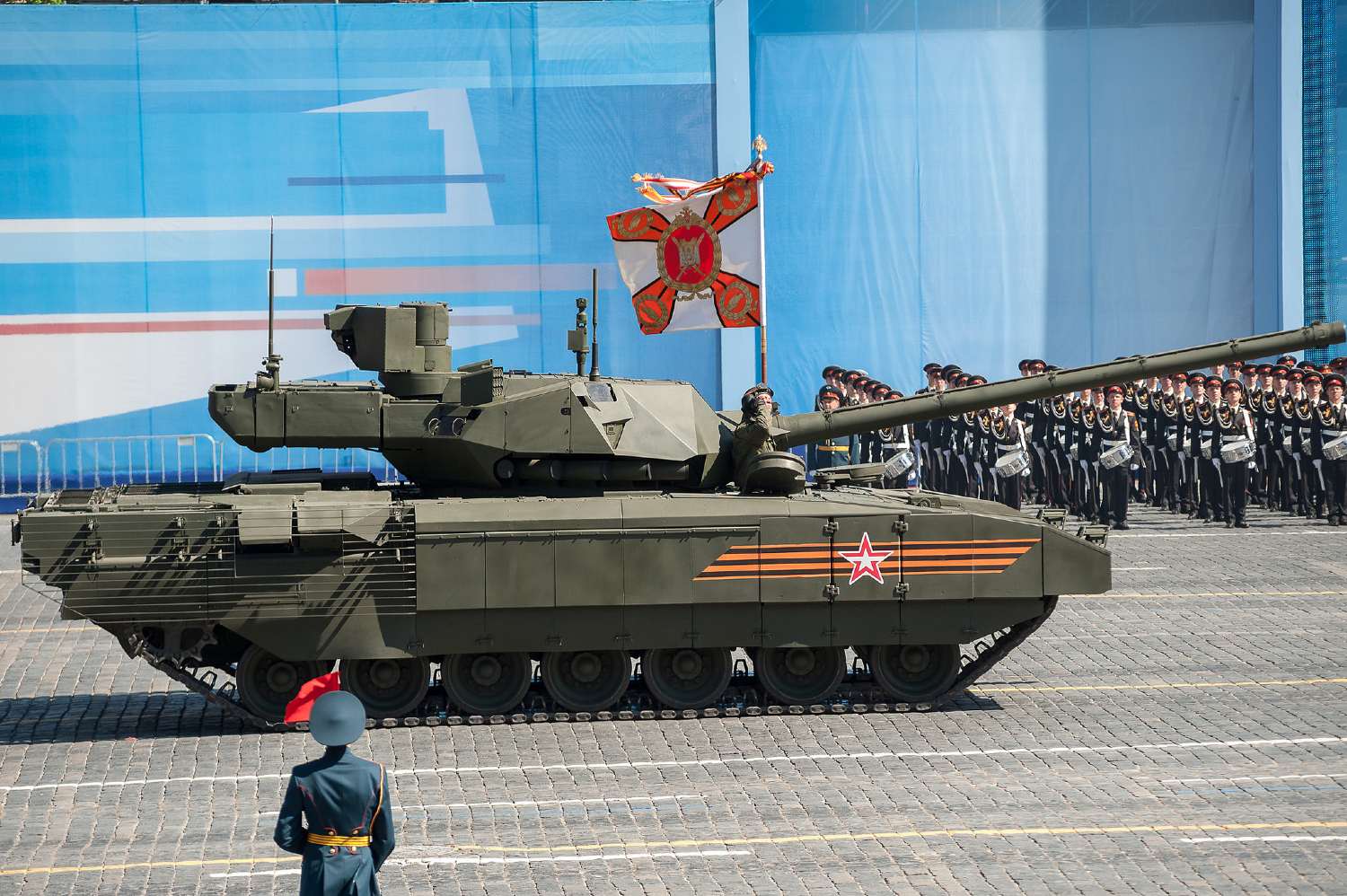A popular French publication ‘La Figaro’ published a report on the deployment of T-14 Armata tanks, calling it the harbinger of a technological revolution and warning that the Western Main battle tanks (MBTs), including the US Abrams and the German Leopard-2s would be bracing for the “unknown.”
It’s Not A Storm, It’s A Hurricane! Russia Braces For Storm Shadow Pain As UK Pulls Out All The Stops On Weapon Supplies
In late April, reports in local Russian media suggested that the military had started to deploy the latest cutting-edge T-14 Armata tanks to Ukraine. It claimed that the Armata had been involved in combat with Ukrainian defensive positions in an unspecified area of the conflict zone but did not take part in direct attacks.
The news of T-14 Armata’s deployment triggered a frenzy among military experts, who immediately compared how the Western tanks, such as the Leopard-2 that had already been delivered to Ukraine and the promised American Abrams tank, would compete against the Russian MBT.
The French publication, which regularly reports on the development from the Ukrainian battlefield, called the T-14 Armata as the “harbinger of technological revolution” and prompted the Western tanks to meet with this never-seen-before technologically advanced Russian battle tank.
“If the German-made Leopard 2s and the American M1 Abrams are far superior to the T-72 or T-80 currently used in numbers by the Russian army, what about the T-14 Armata?”
“If the T-14 steps in, German and American tanks will have to face the unknown,” implying that the Western tanks that have been handed over to Ukraine have no experience of fighting with similar combat vehicles in the past.
The article’s authors observed that the Armata has several advantages over the T-72 and T-90 tanks, including powerful weapons and a special armored capsule for the crew, separated from ammunition and fuel, which increases the chances of the crew surviving even if the tank is knocked out in combat. In addition, the gun barrel does not require human intervention when loading.
The report predicts that T-14 Armata could be a breakthrough on the battlefield as it is designed to operate in conjunction with Infantry Fighting Vehicles (IFVs) and would most likely be used as such. Although Russian media have widely covered the French article, the Armata is yet to participate in combat.
However, the report does come at an opportune moment as Ukraine is preparing to launch a massive counteroffensive against Russia, which could see the largest-ever tank battle between the two nations.
Earlier, EurAsian Times had reported that the anticipated counteroffensive had been marred with delays due to the ‘rasputista’ or the season of soggy black mud in Ukraine that hinders vehicular movement and would prove to impede the Western tanks and Infantry Fighting Vehicles (IFVs) of Ukraine’s army.
The Ukrainian army is ready with its modern Western tanks as Ukraine’s tank brigades have now deployed the sophisticated Leopard-2 tanks and cutting-edge IFVs received from the NATO allies.
Besides the Leopard-2, Kyiv will also deploy the British Challenger-2 MBTs. The US-made Abrams will only arrive by fall this year.

T-14 Armata: Western Tanks Will Face The ‘Unknown’
The T-14 is Russia’s most advanced main battle tank. The Armata Universal Combat Platform, a platform for next-generation modular heavy military tracked vehicles, serves as the foundation for the tank.
One powerful feature of this next-generation tank is the defense systems mounted on it that can effectively shoot down the anti-tank missiles that Ukraine has extensively used against Russian tanks.
Since the early months of the conflict, Ukraine has received an array of Anti-Tank Guided Missiles (ATGMs) and other portable missiles that have obliterated Russian tanks and stalled their advance.
Russia has lost thousands of tanks, including the most advanced tanks deployed – the T-72s and the T-90s and their upgraded variants.
The vast number of tank losses incurred by Russia proved to be a massive setback to the Russian army, so much so that it was forced to pull out archaic Soviet-era tanks like the T-54 and the T-55 from cold storage.
Moreover, the existing tanks have been fitted with cope cages and covered in camouflage to protect them against Ukrainian drones and ATGMs. This is where the Armata comes in.
Russia’s newest tanks T-14 Armata enter battlefield in Ukraine – mediahttps://t.co/0zEobeqOfy pic.twitter.com/LXsKqE4gVR
— RT (@RT_com) April 25, 2023
The T-14 Armata features a sensor-activated defense system that can detect and launch interceptor charges to neutralize missiles and anti-tank shells, further increasing its effectiveness on the battlefield.
The French publication’s warning that the Ukrainian Command and the Western tank prepare for the T-14 Armata is not without reason.
Russia and Ukraine have been operating the same Soviet-legacy tanks that each side has modified and upscaled for combat operations. Ukraine even managed to capture Russia’s T-90 Breakthrough tanks, the most advanced in its fleet.

Military expert Lt Col JS Sodhi told EurAsian Times, “The T-14 Armata is technologically superior to the M1 Abrams and the Leopard tanks. T-14 has a maximum operating range of 310 miles compared to 265 miles for Abrams and 210 miles for a Leopard. Now in armored warfare, the difference in the operating distances means a lot since armored warfare is fluid and dynamic.
“Regarding firepower, a critical component in armored warfare, a T-14 has a 2A82-1M 125mm smoothbore cannon, whereas an Abram has a 120mm L/44 M256 smoothbore gun, and a Leopard has Rheinmetall 120mm gun. The Firepower of T-14 is superior to Abrams and Leopards.”
Ukraine has already received 18 Leopard-2 tanks from Germany and quite a few from Poland, with other allies in the process of completing delivery. In addition, US officials announced on May 11 that the M1A1 Abrams tanks required for training Ukrainian forces have arrived in Germany a little ahead of schedule and are on their way to the Grafenwoehr Army base, where the training will begin in two to three weeks.
According to US Defense Secretary Lloyd Austin, the United States has transported “a number of tanks over into theater” so the Ukrainians may start practicing with them.
The Abrams tanks presently being built for the Ukrainian military will be ready by the time they complete the training, which is anticipated to last around ten weeks. Ukraine is also getting several Leopard-1 tanks to fight the Russians.
Indian Army veteran Col.Rajendra Bhaduri had different views. He told EurAsian Times, “T-14 Armata, as of now, has been produced only in limited numbers. They have not seen active combat. Whatever is known about them is based on Russian manufacturers’ literature and propaganda videos. The claims are of some seriously modern cutting-edge technology that is yet to be battle-proven.
“On the other hand, the Abrams or Leopards, etc., have seen combat. Their weaknesses and strengths are already known. Over the years, after analyzing the performance of these tanks in combat in various wars, the Russians surely would have developed tactics and techniques to counter them using their current generation of tanks already seeing action in Ukraine, i.e., the T72B3, T80BV, T80U, etc.
The limited numbers of T14 reportedly deployed in Ukraine by the Russians are not yet on the frontline.
“It will be interesting to watch the one-on-one tank battle between the Russian tanks by the Russian crew against primarily Leopards as of now since Abrams isn’t coming anytime soon. Not to forget that the Russians have some seriously dangerous versions of ATGMs, both helicopter-launched and ground-launched.”
Neither the Ukrainian army nor the Western tanks have been in a battle against the next-generation T-14 Armata. Earlier, a military official from Russia, Major General Sergey Lipova, had explained that the design and cross-country capabilities of the T-14 Armata tank provide it with a distinct advantage over both the Abrams and Leopard tanks.
Lipova said in an interview that the T-14 Armata had the advantage of being very light, which ensured better maneuverability than the Western tanks, particularly in swampy areas. This would be an advantage now, during the rasputista season when Ukraine is covered in soggy and sticky mud.
- Contact the author at sakshi.tiwari9555 (at) gmail.com
- Follow EurAsian Times on Google News




